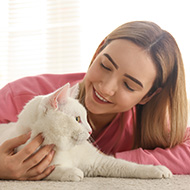Cats can tell when being spoken to, study finds

Research highlights the importance of one-to-one relationships for cats.
Researchers from Paris Nanterre University have found that cats may tune into owners' tone of voice in order to tell whether they are being spoken to.
While the way in which dogs respond to dog-directed speech (DDS) has been the subject of much study, much less research has been done on how cats perceive and respond to cat-directed speech (CDS).
Cat-directed speech in current culture shares features with speech addressed to young children, characterised by a higher pitch and a more melodic tone.
The research team conducted an experiment with 16 companion cats, playing back recordings of their owners using CDS and typical adult-directed speech (ADS), and measured the cat's reaction, noting behaviours that indicate that a cat has tuned-in to a sound.
This playback experiment found that the cats could discriminate between speech addressed to them from speech addressed to other adults when spoken by their owners.
However, when played sentences in ADS and CDS spoken by strangers, the cats did not appear to distinguish between the two.
Charlotte de Mouzon, lead author for the study, told The Guardian: For a long time it has been thought that cats are very independent creatures, only interested in [humans for] eating and shelter, but the fact that they react specifically to their owner, and not just anybody addressing them, supports the idea that they are attached.
“It brings further evidence to encourage humans to consider cats as sensitive and communicative individuals.”
'Discrimination of cat-directed speech from human-directed speech in a population of indoor companion cats (Felis catus)' has been published in Animal Cognition.



 The RCVS has announced a new version of its 1CPD mobile app, with enhanced features for veterinary surgeons and veterinary nurses to record their continuing professional development.
The RCVS has announced a new version of its 1CPD mobile app, with enhanced features for veterinary surgeons and veterinary nurses to record their continuing professional development.